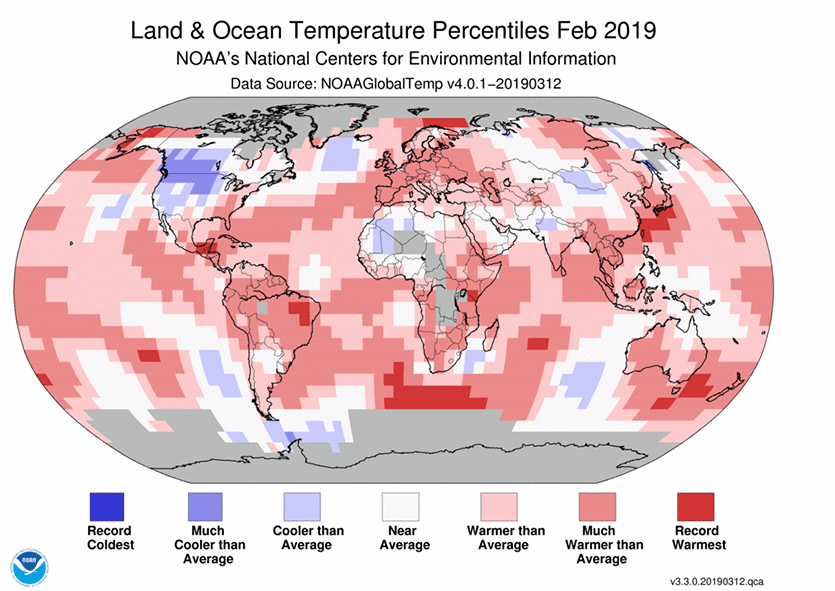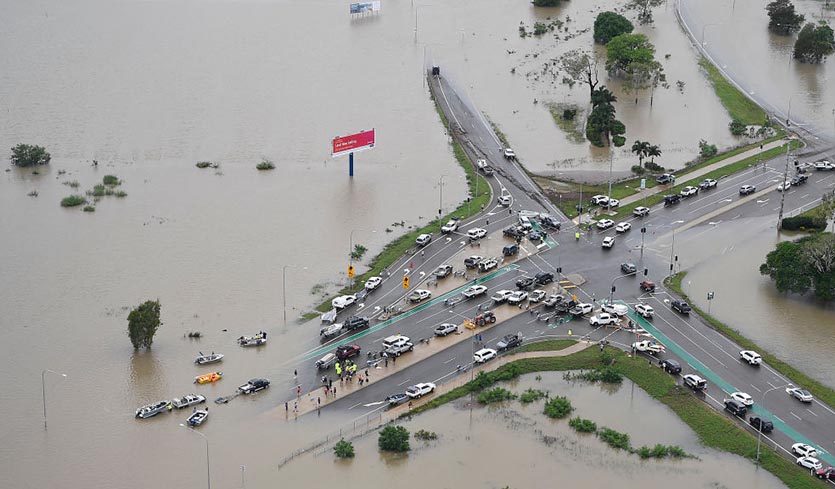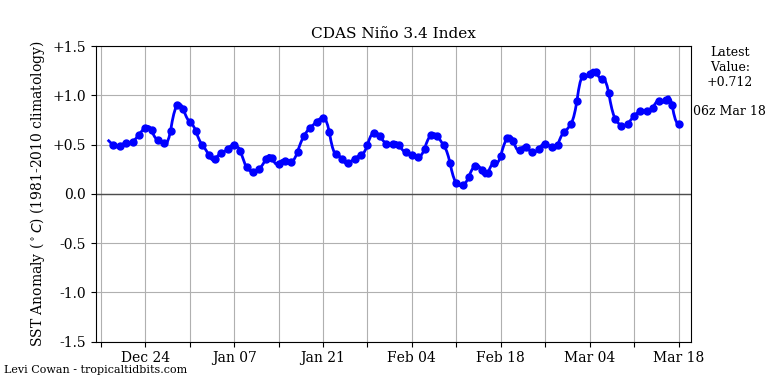| Above: A woman does a Sudoku puzzle in St. James's Park among the daffodils as the sun shines in central London on February 26, 2019, when Britain experienced its warmest February day on record: 21.2°C (70.2°F) at Kew Gardens. Image credit: NIKLAS HALLE'N/AFP/Getty Images. |
February 2019 was the planet's fifth warmest February since record keeping began in 1880, said NOAA's National Centers for Environmental Information (NCEI) on Monday. According to NOAA, the only warmer Februaries were in 2016, 2017, 2015, and 1998. NASA rated February 2019 as the third warmest February on record, behind only 2016 and 2017. Minor differences in rankings between NASA and NOAA can arise because of how they handle data-sparse regions such as the Arctic, where few surface weather stations exist. The Japan Meteorological Agency ranked February as the fourth warmest since 1891.
Global ocean temperatures during February 2019 were the second warmest on record, according to NOAA, while global land temperatures were only the fifteenth warmest on record, as the land readings were brought down by the widespread cold across North America. It was the second warmest February on record for the Southern Hemisphere. The December-through-February Northern Hemisphere winter was the sixth warmest on record, while the Southern Hemisphere December-through-February summer temperatures were the second warmest on record.
Global satellite-measured temperatures in February 2019 for the lowest 8 km of the atmosphere were the fifth or fourth warmest in the 41-year record, according to the University of Alabama Huntsville (UAH) and RSS, respectively.
 |
| Figure 1. Departure of temperature from average for February 2019, the fifth warmest February for the globe since record keeping began in 1880, according to NOAA. The Southern Ocean off the southern coast of South Africa was record warm, along with parts of Alaska, Central America, the Barents Sea, the Southern Ocean off Australia's southeastern coast, the Indian Ocean, the East China Sea as well as parts of northeastern Brazil. Parts of the northern U.S. and southern Canada were much colder than average. Image credit: National Centers for Environmental Information (NCEI). |
One billion-dollar weather disaster in February 2019
One billion-dollar weather-related disaster hit the Earth last month, according to the February 2019 Catastrophe Report from insurance broker Aon: flooding in Australia’s North Queensland that caused $1.2 billion in damage. The deadliest weather-related disasters of February were floods in Pakistan and in Zimbabwe that killed 26 people each. Here is the tally of billion-dollar weather disasters so far in 2019:
- Flooding, Argentina, Uruguay, Paraguay, and Brazil, 1/1 – 1/20, $2.3 billion, 5 killed
- Flooding, Australia, 1/28 – 2/7, $1.2 billion, 3 killed
 |
| February Billion-Dollar Disaster 1. Australia’s Northern Queensland experienced widespread flooding from January 28 to February 7, with the most significant impacts reported in the Townsville region. Three people were killed, and damage was estimated at $1.2 billion. Above: A flooded major intersection in Townsville, Australia’s suburb of Idalia on February 04, 2019. Image credit: Ian Hitchcock/Getty Images. |
 |
February Billion-Dollar Disaster 2. A massive four-day winter storm brought hurricane-force wind gusts, severe flooding, the first tornado death of 2019, and heavy snows to the U.S. on February 22 – 26. The storm’s winds left over 550,000 customers without power; Pennsylvania topped the list, with 160,000. Winds gusting as high as 74 mph on the east shore of Lake Erie, at Niagara, pushed a surge of water from the lake onto the shore, creating massive piles of ice and flooding. In all, the storm was blamed for 4 deaths and $1.35 billion in damage. Above: A child plays around the podium that was virtually undamaged or moved in the tornado that destroyed First Pentecostal Church in Columbus, Miss., Sunday morning, Feb. 24, 2019. (AP Photo/Rogelio V. Solis) |
El Niño strengthens
NOAA continued its El Niño Advisory initially issued in January. “Weak El Nino conditions are present and are expected to continue through the Northern Hemisphere spring 2019 (~80% chance) and summer (~60% chance),” NOAA declared in the advisory, issued on March 14.
Weak El Niño conditions strengthened in February, with surface temperatures (SSTs) that increased across the central and eastern tropical Pacific. The atmospheric response to these increasing SST became more defined, consistent with what we expect to see in a weak El Niño event. SSTs in the Niño3.4 region—the one that’s most often used to diagnose El Niño and La Niña—must be at least 0.5°C above average for five overlapping three-month periods for an official El Niño event to be ordained. Thus far we have four such periods (September-November, October-December, November-January, and December-February).
Although it is difficult to predict the state of El Niño and La Niña with confidence beyond springtime, when such forecasts are at their most uncertain, the odds are gradually increasing that the year 2019 will be dominated by El Niño conditions—which in turn raises the odds that 2019 will be one of the warmest years on record, in line with the period 2014-2018.
 |
| Figure 2. Departure of sea surface temperatures (SSTs) in the benchmark Niño 3.4 region (in the equatorial Pacific). Over the past three weeks, SSTs have been above the 0.5°C above-average threshold needed for an El Niño event. Image credit: Levi Cowan, tropicaltidbits.com. |
Arctic sea ice had its seventh lowest February extent on record
Arctic sea ice extent during February 2019 was the seventh lowest in the 41-year satellite record, according to the National Snow and Ice Data Center (NSIDC). However, in the Bering Sea between Alaska and Russia, ice extent on March 1 was the lowest in the satellite record for this time of year, thanks to an unusually strong and persistent weather pattern that drew in warm air from the south. Storms also broke up large areas of ice near the ice edge and reduced the sea ice extent.
Antarctic sea ice extent likely reached its minimum for the summer on February 28 - March 1, bottoming out at the seventh lowest on record.
Notable global heat and cold marks for February 2019
Hottest temperature in the Northern Hemisphere: 43.7°C (110.7°F) at Renk, South Sudan, 26 February
Coldest temperature in the Northern Hemisphere: -56.7°C (-70.1°F) at Delyankir, Russia, 15 February
Hottest temperature in the Southern Hemisphere: 47.6°C (117.7°F) at Learmonth, Australia 25 February
Coldest temperature in the Southern Hemisphere: -56.8°C (-70.2°F) at Concordia, Antarctica, 24 February
(Courtesy of Maximiliano Herrera.)
Major weather stations that set (not tied) all-time heat or cold records in February 2019
Among global stations with a period of record of at least 40 years, 20 set new all-time heat records in February (two of them accomplishing that feat twice) and 5 set all-time cold records.
Traiguen (Chile) max. 40.7°C, 2 February
Temuco (Chile) max. 40.7°C, 3 February
Valdivia (Chile) max. 38.5°C, 3 February
Puerto Aysen (Chile) max. 35.3°C, 3 February
Balmaceda (Chile) max. 35.3°C, 4 February
Rio Bueno (Chile) max. 38.0°C, 4 February
Puerto Montt (Chile) max. 35.1°C, 4 February
Lord Cochrane (Chile) max. 36.1°C, 4 February
Osorno (Chile) max. 37.3°C, 4 February
Coyhaique (Chile) max. 36.1°C, 4 February
Perito Moreno (Argentina) max. 38.2°C, 4 February
Rio Grande (Argentina) max. 30.8°C, 4 February
Puerto Santa Cruz (Argentina) max. 37.0°C, 4 February
Sea Lion Island (Falkland Islands, United Kingdom) max. 21.7°C, 5 February
Punta Arenas Airport (Chile) max. 28.7°C, 5 February
Rio Gallegos (Argentina) max. 35.8°C, 5 February
Coronach (Canada) min. -46.5°C, 8 February
Shigeno Inui (Japan) min. -13.8°C, 8 February
Teshikaga (Japan) min. -26.7°C, 9 February
Lake Akan (Japan) min. -30.7°C, 9 February
Taiki (Japan) min. -29.8°C, 9 February
Esquel (Argentina) max. 35.6°C, 15 February
Traiguen (Chile) max. 42.4°C, 15 February
Temuco (Chile) max. 41.1°C, 15 February
Espinheira (Angola) max. 41.0°C, 16 February: New national record high for Angola
Salvador (Brazil) max. 37.1°C, 17 February
Thiruvananthapuram (India) max. 38.2°C, 20 February
(Courtesy of Maximiliano Herrera.)
WU weather historian Christopher C. Burt had a round-up of the many winter weather records in a post last week.
Three all-time national heat records set or tied in 2019
Christmas Island (Australia), 31.6°C (88.9°F), 19 January
Reunion Islands (France), 37.0°C (98.6°F), 25 January
Angola, 41.0°C (105.8°F), 16 February
No all-time national cold records have been set thus far in 2019. Most nations do not maintain official databases of extreme temperature records, so the national temperature records reported here are in many cases not official. I use as my source for international weather records researcher Maximiliano Herrera, one of the world's top climatologists, who maintains a comprehensive list of extreme temperature records for every nation in the world on his website. If you reproduce this list of extremes, please cite Maximiliano Herrera as the primary source of the weather records.
Twenty-four monthly national heat records beaten or tied in 2019
January: Micronesia, Paraguay, Angola, Equatorial Guinea
February: Chile, Marshall Islands, Guyana, United Kingdom, Denmark, Sweden, Netherlands, Belgium, Luxembourg, Andorra, Austria, Hungary, Jersey, Guernsey, Slovakia, San Marino, Slovenia
March: Australia, Marshall Islands, Angola
No monthly national cold records have been beaten or tied in 2019.
Hemispherical and continental temperature records in 2019
Highest minimum temperature ever recorded in the Southern Hemisphere: 35.9°C (96.6°F) at Noona, Australia, 18 January. The record was beaten again on 26 January, with a minimum temperature of 36.6°C (97.9°F) recorded at Borrona Downs, Australia. This is also the highest minimum temperature on record for the globe for the month of January.
Highest temperature ever recorded in the world in March: 48.1°C (118.6°F) on 10 March at Roebourne, Australia.
March Madness weather forecasting contest
If you want to try your luck (or skill) at forecasting, the University of Michigan Department of Climate and Space Sciences and Engineering is sponsoring its annual "Weather Dance" forecasting contest for the duration of the NCAA basketball tournament. The 2019 Weather Dance combines the NCAA Men’s and Women’s basketball tournaments with weather forecasting and challenges amateur forecasters to predict which team’s city will be hotter or colder on game day in each round of the men’s and women’s tournaments. To register, visit https://www.weatherdance.org. After you sign up, you’ll get an email announcing when the brackets have been finalized and you can enter your picks. The winning K-12 teacher in each category will receive a trophy and a copy of “Extreme Weather: A Guide and Record Book” by Christopher C. Burt. Other winners will receive an extreme weather mug.
We'll have a new post Monday afternoon on the aftermath of Tropical Cyclone Idai in Mozambique.




